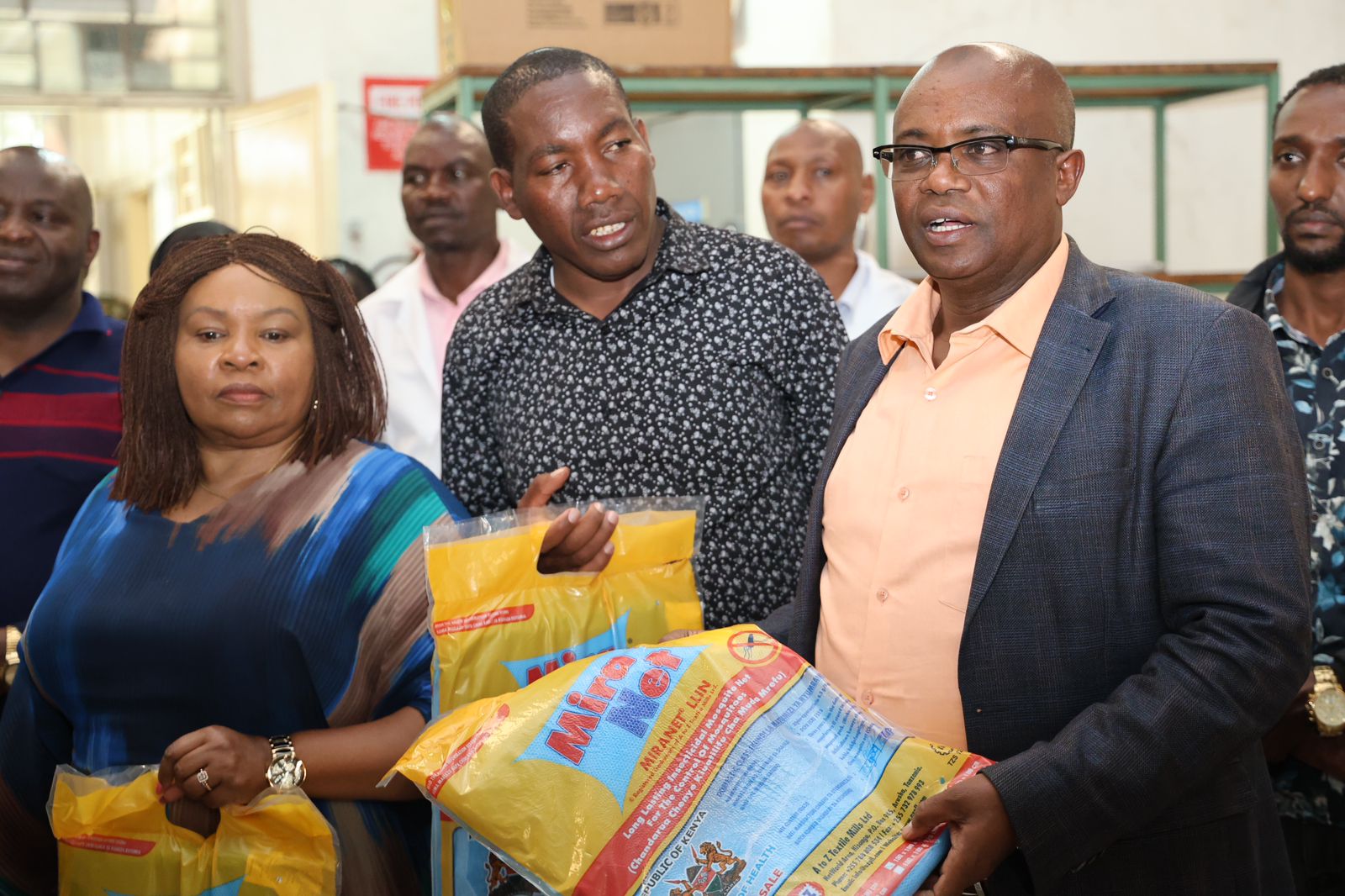The final phase of the mass distribution of 10.9 million Long-lasting Insecticidal nets (LLINs) by Kenya Medical Supplies Authority (Kemsa) in 20 high malaria-burden counties is underway.
Baringo County is the most recent beneficiary of the 2023/2024 campaign, which was launched last year in November by the government and its partners to prevent malaria. The county, which experiences seasonal transmission of the disease, has received 298,000 nets for households in Eldama Ravine, Mogotio, and Baringo South sub-counties.
The KEMSA board and management, along with the county government, flagged off the nets in response to a rise in infections in North Rift County due to prolonged rains.

During an assessment and evaluation tour of the Nakuru depot, KEMSA CEO Dr. Waqo Dulacha commended the smooth distribution process carried out in collaboration with the county governments. He noted that 17 out of the 18 counties, grouped into five clusters, have already received the nets, which have a lifespan of three years.

With only Turkana County remaining in the last cluster, Kemsa is preparing to implement the initiative in two additional counties, Nandi and Kericho, covering 20 counties.
Furthermore, four other counties have been reached through the U.S. President’s Malaria Initiative, facilitated by the United States Agency for International Development (USAID).
“We are excited as Kemsa family to have been involved in the last mile distribution of LLINs in 18 counties. Our main target is children under 5 years, pregnant women who will be saved from malaria. LLINs are a great intervention that will go a long way in saving lives in the affected counties” said Waqo.
“Global fund is the main supporter alongside USAID. They have supported us through the National Treasury and the Ministry of Health to the tune of 10.9 million nets. Four counties have been distributed through other mechanisms but we are going to 18 counties,” he added.
The KEMSA boss expressed gratitude to the government, Global Fund, and the US government for entrusting the agency with the delivery of essential commodities at the household level.
Registered beneficiaries are receiving text messages on their mobile phones, informing them of the locations where they can collect the mosquito nets.

“Kemsa expertise in the last mile delivery will go along in ensuring funds allocated from our partners and government are used prudently. We have ensured the commodities reach the intended destinations particularly the households. Because of our ability to distribute medical commodities, we have been able to penetrate the remotest areas despite challenges of terrain and rains” he added.
Previously, the state solely stored the nets in their warehouse.
“We thank our partners who have given us this task to do the last mile distribution for the confidence they have had in Kemsa to distribute the nets we have warehoused” he said.
On his part, the chair of the board session, Hezborn Omollo, stated that the agency had completed 89pc of the assignment.

“We are here as a board of KEMSA and senior management to appreciate what our team has been doing. We are glad to note that as of today close to 89pc of the assignment is done and what remains is a few counties so this is a wrap” he told journalists.
Malaria Prevalence
Meanwhile, Baringo Deputy Governor Felix Maiyo is urging residents in the three sub-counties with a population of 474,000 to utilize the nets correctly to contain the spread of the disease.

While emphasizing prevention and social behavioural change, Maiyo, who was speaking during the launch of the malaria control program at Muserechi dispensary in Eldama Ravine, a hot spot for highland malaria, said the area will receive over 95,000 nets.
Baringo South, also classified as a malaria zone because of irrigation schemes, will receive 80,000 nets, and Mogotio will receive 72,000 nets.
 According to July data, the county has recorded a malaria resurgence with a positivity rate of 16.5pc.
According to July data, the county has recorded a malaria resurgence with a positivity rate of 16.5pc.
Faith Changwony, the County Malaria Coordinator, revealed that 10,933 tests were conducted, with 1,806 samples testing positive.
The tests showed that 369 children under five years tested positive, while 1,249 cases were reported in those above five years. During the same period, 188 cases were detected by Malaria rapid diagnostic testing out of 1,080 samples.
At the same time, surveillance teams have been dispatched to Tiaty West following a flare-up of the disease, which is affecting 40pc of the population.

Changwony says the upsurge is mainly concentrated along the Kerio belt, particularly in Tiaty East and West, which has been attributed to rains and the nomadic lifestyle of area residents.
Although mosquito net distribution programs have been effective in malaria control, the Ministry of Health is enhancing social and behaviour change interventions in the affected areas.
Residents have been advised to clear bushes and stagnant water, which create breeding grounds for mosquitoes, especially after heavy rains.

Clusters
The Western, Nyanza, and Coast regions, which have recorded a high number of malaria positivity cases, have so far received the bulk of the treated bed nets.
The counties are grouped into five clusters: Cluster One includes Kisumu, Siaya, Busia, Migori, Kisii, and Nyamira; Cluster Two has Lamu, Kilifi, Tana River, Kwale, Taita Taveta, and Mombasa; while Cluster Three consists of Bungoma, Kakamega, Vihiga, and Homa Bay.
Cluster Four includes West Pokot, Turkana, and Trans Nzoia, while Cluster Five is made up of Narok, Baringo, and Kirinyaga. The LLINs distribution campaign is done once every three years. The first mass distribution campaign for universal coverage took place in 2006, where 3.4 million nets were distributed.
Watch https://youtu.be/uxIyoC0h3uI?si=hy5Kd5JNWQirAIXE





